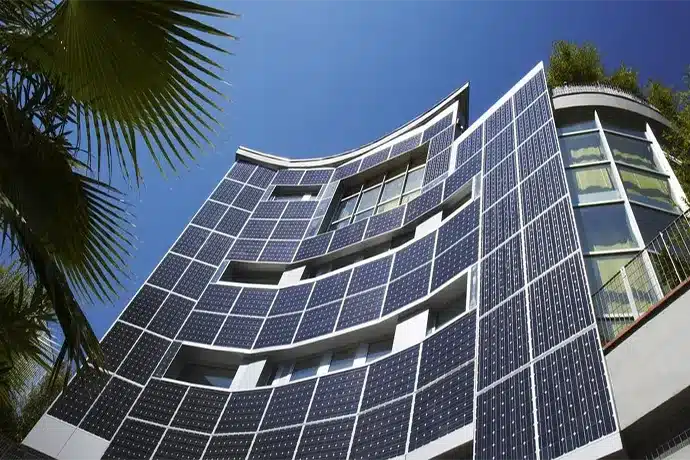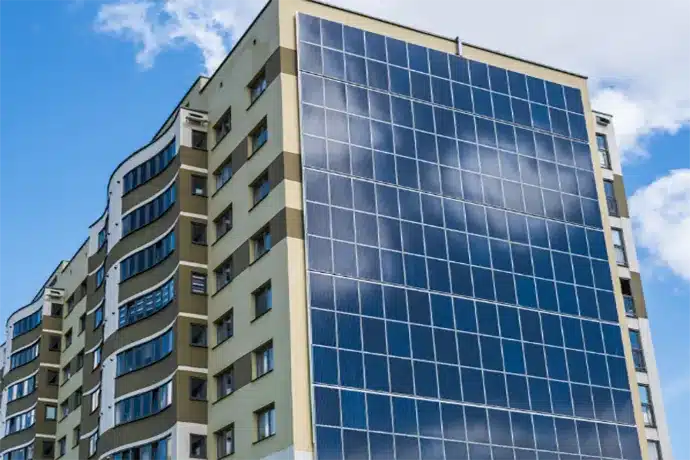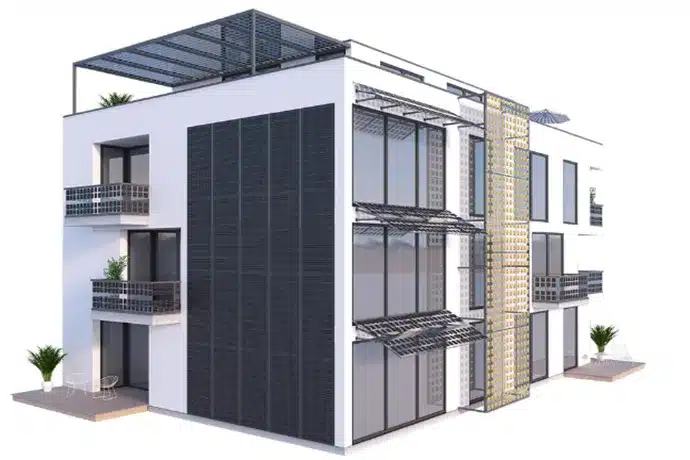Table of Contents
1. What is BIPV?
Building Integrated Photovoltaic (BIPV) is a solar power product or system that is seamlessly integrated as part of the building envelope and building components such as exterior walls, roofs or windows.
Solar power generators can be mounted on the skin of a building, which makes it possible to combine power generation with other functions of the building material. In view of the advantages of PV building integration, more and more countries are setting targets for the use of solar PV in buildings targets, as PV building integration represents a significant advance in the application of solar PV in cities.Solar photovoltaic systems not only save on conventional energy use, but also offset the peak generation of coal and oil as well as the emissions from diesel generators. Energy efficiency is a very important deciding factor for the use of PV in buildings today..
BIPV products transform buildings from energy consumers to energy producers. In this process, it is necessary to combine the product technology with BIPV technology to satisfy the better performance of the BIPV products become a real building element, which can be used as the external wall of the building, such as the roof, façade, skylight, but also to play the role of wind and rain, heat insulation, sound insulation and so on.
Installations of BIPV products are increasing year on year. Engineers and designers are using BIPV products in innovative ways, and manufacturers are creating new products to meet market demand. Some BIPV companies, such as Schott solar, Sanyo, Sharp and Sun-tech, are developing new BIPV products for curtain walls, skylights and windows. In the coming years, BIPV product technology is likely to be widely accepted in other parts of the world such as Asia Pacific, Latin America, Europe and South Africa.

2. Comparison between ordinary PV and BIPV
| Conventional photovoltaic modules | BIPV components |
| More common around the world with significant infrastructure | Infrastructure, standards not in place, need to build expertise |
| The efficiency of solar panels has been steadily increasing while prices have been falling | Smaller market, many technologies still under development, not competitive with conventional panels in terms of retail price |
| Durable, with a service life of 25-30 years | Can replace virtually all exterior materials, thereby reducing the total cost of the building through operating cost savings and energy reductions |
| Limited mounting options, typically roof or ground mounted | Aesthetically pleasing and can be seamlessly integrated with the building envelope, resulting in a stylish and modern building appearance. |
3. Comparative analysis of different BIPV products
| Product | Specific Advantage | Specific Disadvantage | Applications |
| Standard systems for roofs | l Suitable for new and old roofs
l Prove application l Easy to operate l Very competitive l Efficient performance |
l Limited aesthetic value
l Applicability limited to certain roof types l Versatility of photovoltaics not fully utilized |
Pitched roof |
| Semi-transparent
System (Glass/Glass Modules |
l The most unobtrusive, and possibly the most aesthetically pleasing, BIPV solution
l Ideal for facade and skylight buildings l Attractive cell shape l Thin film cells have a uniform appearance and are suitable for recessed installations |
l Usually customized and more expensive
l Difficult to hide cables l Cells are limited in size and shape |
l Elevation
l Skylights l Sunshade system |
| Cladding systems | l Can include different colors and visual effects
l Highly efficient |
l Lower system performance due to design limitations
l Lower portion of elevation may not be used due to shadowing l High installation costs |
Curtain Walls |
| Solar tile | l Aesthetically pleasing, primarily for residential sloped roofs
l High efficient l Lightweight and easy to install |
l Smaller size and longer installation time
l Less cost effective l High risk of breakage |
Pitched roof |
4. Advantages of BIPV
- The use of this system does not require additional land area to produce solar energy
- Itreduces the power consumption of the premises by providing sufficient daylight and reducing the load on the cooling equipment
- Since it is suitable for roofs and facades, it provides a return on investment in the form of solar power generation
- The flexibility and diverse applications of building-integrated solar modules provide builders and designers with excellent opportunities to enhance the visual appeal of buildings



























